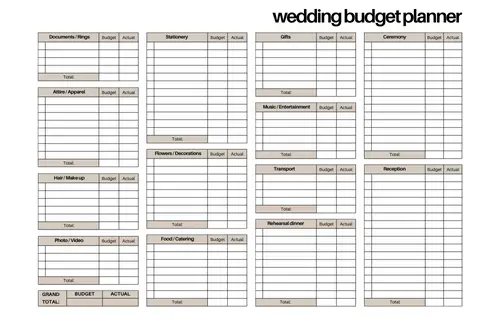What is the best way to create a budget banzai? Budgeting may seem like a daunting task, but it’s the key to achieving financial freedom and reaching your money goals.
Listing all your anticipated monthly expenses is the first step towards creating a solid budget plan.
The answer is simple – listing all your anticipated monthly expenses. By tracking your spending habits and categorizing your expenses, you’ll gain a clear understanding of where your money is going.
In this article, we’ll explore the importance of budgeting, provide a step-by-step guide to listing your expenses, and share strategies for creating a detailed budget plan that aligns with your financial goals. We’ll also offer practical tips to help you stick to your budget and achieve long-term success.

what is the best way to create a budget banzai?
The best way to create a “budget banzai” is by listing all your anticipated monthly expenses. This involves:
- Gathering financial documents like bills, bank statements, and receipts to understand your spending habits.
- Categorizing your expenses into buckets like rent, utilities, groceries, transportation, entertainment, etc.
- Tracking every single expense for a month or two to get an accurate picture of your spending patterns.
- Estimating variable expenses like utilities that fluctuate monthly based on past trends.
- Including irregular expenses like annual subscriptions or car insurance by dividing the cost over 12 months.
By comprehensively listing out all your monthly expenses, you build the foundation for creating a detailed budget plan that allocates your income effectively across needs, wants, and financial goals. This budget “banzai” allows you to gain control over your finances.
The Importance of a Budget
Before we get into the nitty-gritty of budgeting, let’s talk about why it’s so darn important. A budget is like your personal financial GPS – it helps you navigate through the maze of expenses and income, ensuring you stay on track and reach your desired destination.
Without a budget, you’re essentially driving blindfolded, with no idea where your money is going or how much you’re spending.
Why is having a budget so crucial?
Well, my friend, a budget gives you control over your finances. It allows you to:
- Understand where your money is coming from and where it’s going
- Identify areas where you can cut back on expenses
- Plan for future goals, like buying a house or saving for retirement
- Avoid overspending and falling into debt
- Achieve financial freedom and peace of mind
Essentially, a budget puts you in the driver’s seat of your financial life, empowering you to make informed decisions and reach your goals faster.
How do I list my expenses effectively?

Here’s a step-by-step guide to help you get started:
- Gather Your Financial Documents: Gather all your recent bills, bank statements, and receipts. This will give you a clear picture of your spending habits.
- Categorize Your Expenses: Create categories for your expenses, such as rent/mortgage, utilities, groceries, transportation, entertainment, and so on. This will help you organize your spending and identify areas where you might be overspending.
- Track Your Spending: For a month or two, keep track of every single expense, no matter how small. Use a notebook, spreadsheet, or budgeting app to record each purchase. This will give you an accurate picture of your spending patterns.
- Estimate Variable Expenses: Some expenses, like utilities or grocery bills, may vary from month to month. Try to estimate these based on your past spending patterns.
- Don’t Forget Irregular Expenses: Include expenses that occur less frequently, such as car insurance, property taxes, or annual subscriptions. Divide these by 12 to get a monthly estimate.
What if I have irregular or unpredictable expenses?
Great question! For irregular or unpredictable expenses, like car repairs or medical bills, it’s a good idea to set aside a contingency fund within your budget. This will help you stay prepared for any unexpected costs that may arise.
How do I create a detailed budget plan?
Here’s a step-by-step guide to help you out:
- Calculate Your Total Monthly Income: Add up all your sources of income, including your salary, any side hustles, or passive income streams.
- Subtract Your Monthly Expenses: Take your total monthly expenses and subtract them from your total monthly income. This will give you an idea of how much money you have left over (or if you’re overspending).
- Prioritize Your Spending: Divide your expenses into categories like “needs” (rent, utilities, groceries) and “wants” (entertainment, dining out, subscriptions). Prioritize your needs first and allocate funds accordingly.
- Set Financial Goals: Decide on your financial goals, such as paying off debt, saving for a down payment, or building an emergency fund. Allocate a portion of your budget towards these goals.
- Adjust and Revise: Your budget is not set in stone. As your income or expenses change, be sure to adjust and revise your budget accordingly.
Here’s an example of what your budget plan might look like:
| Category | Amount |
|---|---|
| Income | $4,000 |
| Rent | $1,200 |
| Utilities | $200 |
| Groceries | $400 |
| Transportation | $150 |
| Debt Payments | $500 |
| Savings/Investments | $500 |
| Entertainment | $300 |
| Other Expenses | $200 |
| Total Expenses | $3,450 |
| Remaining | $550 |
In this example, you have $550 left over after accounting for all your expenses. You can choose to allocate this towards additional savings, investments, or even treat yourself to something fun (within reason, of course!).
Sticking to Your Budget
Creating a budget is just the first step – the real challenge lies in sticking to it. But don’t worry, we’ve got some tried-and-true tips to help you stay on track.
Here are some helpful strategies:
- Automate Your Savings: Set up automatic transfers from your checking account to your savings or investment accounts. This way, you’ll never forget to save, and you won’t be tempted to spend that money.
- Use Cash for Discretionary Spending: Withdraw a set amount of cash each week for discretionary spending, like dining out or entertainment. Once the cash is gone, you’re done spending for the week.
- Track Your Spending Regularly: Review your spending regularly and make adjustments as needed. This will help you stay accountable and identify areas where you might be overspending.
- Involve Your Partner or Family: If you have a partner or family, involve them in the budgeting process. Having a support system can help you stay motivated and on track.
- Celebrate Your Wins: When you reach a financial milestone or stick to your budget for a certain period, celebrate your success! This will reinforce positive behavior and keep you motivated.
Conclusion
Creating a budget banzai might seem daunting at first, but trust me, it’s a game-changer when it comes to achieving your financial goals.
By listing all your anticipated monthly expenses and creating a detailed budget plan, you’ll gain control over your finances and pave the way for a brighter future.
Remember, budgeting is not a one-time event – it’s an ongoing process that requires consistent effort and adjustment.
But with the right mindset and strategies, you’ll be able to stick to your budget and watch your financial dreams become a reality.
So, what are you waiting for? Grab a pen and paper (or fire up that budgeting app), and start your budget banzai today! Your future self will thank you.
[su_button Id= download url=”https://selffinance.info/how-much-money-do-college-students-spend-per-month/” target=”blank” size=”10″]CLICK HERE[/su_button]






7 thoughts on “what is the best way to create a budget banzai?”